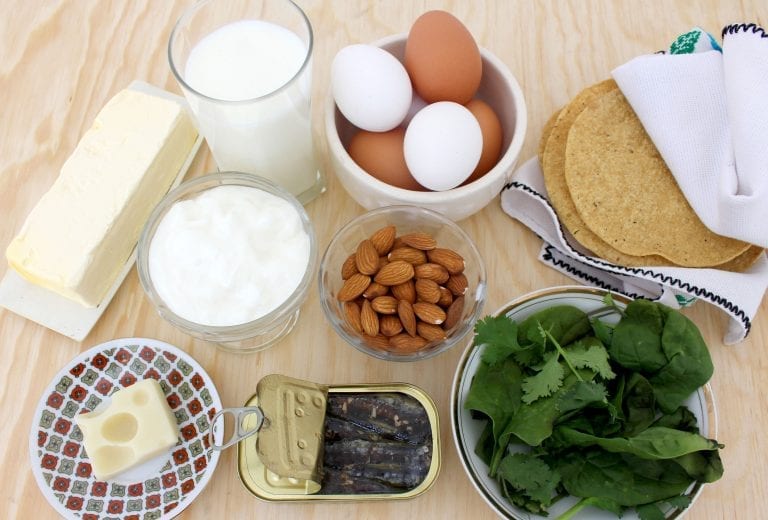Here’s a 3-pronged plan to promote bone health and help prevent osteoporosis: Calcium, vitamin D and exercise!
Did you know that after a certain age, your body no longer creates any new bone density? Sometime between the ages of 30 and menopause, your body stops adding bone density to your skeleton. This is why it’s so important to bone up on bone health—and build as much bone as possible from your late teen through early adulthood.
What is osteoporosis?
Osteoporosis is a medical condition wherein our bones become brittle, thin and fragile. On X-ray pictures, bones affected by osteoporosis look like Swiss cheese, and they’re more likely to break if you fall or have an accident. Having weak, thin bones increases your chances of developing osteoporosis later in life. Osteoporosis is common: More than 54 million people have it, and 1 in 2 women will have a fracture or break a bone related to osteoporosis during her lifetime.
Just being a female in menopause makes you more likely to have brittle, thin bones. So does:
- being Asian or Caucasian
- being very thin or petite
- having a family history of osteoporosis
- having a mother who had a hip fracture related to thin bones
- smoking cigarettes
- drinking a lot of alcohol or caffeinated drinks
- using certain medications including steroids (for more than 3 months)
- taking some medications to treat breast cancer.
Can osteoporosis be prevented?
As a woman, even if you’re age 30 or older and have already reached your peak bone mass, it’s important to get enough calcium in your diet to keep your bones strong. Dairy and dark leafy greens are your best food sources; supplements are effective too. Ask your nurse what kind of supplements may work best for you based on any medical conditions and medicines you may be using.
Curious about calcium-containing foods? Check out the calcium calculator at the National Osteoporosis Foundation online at nof.org for information on calcium from food. How Can I Save My Bones?
You’ve got 3 great tools to support your bones: calcium, vitamin D and exercise. Calcium is key to saving bones. Experts at the National Institutes of Health recommend 1,000 mg of calcium daily for women ages 19-50; bump up that recommended daily intake to 1,200 mg after you celebrate your 51st birthday.
Vitamin D is calcium’s partner and experts agree you’ll also need plenty of it to keep your bones strong. Unfortunately, vitamin D is a bit harder to get from food.
While sunshine is a good natural source for vitamin D, it’s hard to get enough unless you live in the southeast part of the US. And even if you live somewhere like sunny Florida, wearing sunscreen or a hat blocks natural vitamin D. Consider taking a D supplement—600 IU each day up to the age of 70, when your RDA bumps to 800 IU a day. Some studies recommend more, but never exceed 4,000 IU per day.
Lastly, add in weight-bearing exercise (pretty much anything other than swimming) to keep your bones healthy and strong. Walking – even without holding weights– is an easy way to keep your skeleton strong.
Osteoporosis and pregnancy
You may have heard that during pregnancy, your baby actually takes some of your calcium from your bones and teeth to grow their own strong skeleton. This makes getting enough calcium during pregnancy even more important so that your bones don’t become thinner as your nourish your baby.
Check your prenatal vitamin—if you don’t have at least 1,000 mg of calcium, talk with your nurse about adding a calcium supplement. If you’re age 18 or younger, your recommended daily need is 1,300 mg.
And your need for calcium continues through breastfeeding: You lose a small bit of calcium through breast milk, and this can affect your bones, so you might want to consider a supplement. Continue to take vitamin D, too. Your nurse may recommend taking a little more—1,000–1,500 IU each day—during pregnancy and breastfeeding. And don’t forget exercise—this is a habit you’ll always need for a healthy life!
How can I know if I’m at risk for osteoporosis?
Routine testing of your bone density isn’t generally recommended until you’ve gone through menopause, which happens for the average American woman between ages 48-55. If you’re not yet menopausal and are taking medications that can cause bone loss, like steroids, your nurse may want to get a bone density baseline.
Once you’ve reached menopause, and definitely by age 65, you’ll want to have a bone density test called DEXA. This screen is recommended to check the density and strength of your bones and determine your risk for fracture. The DEXA test is painless and involves a very low-level X-ray of your spine and hip and sometimes your wrist.
Talk to your nurse to learn when you should start DEXA testing and how often to do it. You can also talk to your nurse about checking your vitamin D levels. If your level is found to be low, you may need to take higher amounts or even prescription-strength vitamin D. However, vitamin D level testing isn’t recommended during pregnancy.
You may not often think about your bones, but they are living, active parts of you! And you have the power to prevent bone fractures with simple plans to get enough calcium and vitamin D from food and supplements and exercise regularly. You also have the power to make sure your children and teens get enough calcium and exercise during the very important younger years when they are still making strong bone every day. This strength will carry them into adulthood with a solid skeleton and healthy body.






Comments are closed.